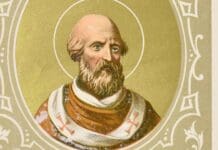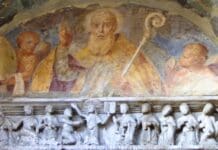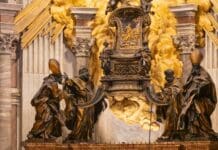During the pontificate of Pope Saint Julius I, from 337 to 352, the Roman Church faced a significant challenge from the Eastern Arians. Despite the Council of Nicaea’s condemnation of Arianism, the sect found increasing support, even influencing Emperor Constantine and his successor in the East, Constantius.
Julius, stepping into the role after a mysterious four-month vacancy following Mark, was soon approached by delegates from Alexandria. They sought his recognition of Pistus as the bishop of Alexandria, claiming that Athanasius, a staunch defender of orthodoxy and a target of Arian scheming, had been rightfully deposed. In response, Athanasius dispatched envoys, and later, presented himself in Rome to argue his case before Julius. The Arians proposed a synod to adjudicate the matter. However, when Julius convened it in 341, they abstained from participation. The Pope proceeded without them, and the gathering of over fifty bishops reinstated Athanasius, deeming his condemnation unjust. Julius conveyed his displeasure with the Arians’ lack of cooperation in a message to Alexandria.
Emperor Constans of the West showed sympathy towards orthodoxy, in contrast to his brother Constantius of the East, who leaned towards Arianism. A significant council was agreed upon by both emperors, aiming for religious unity, a move Pope Julius endorsed. He sent representatives to Sardica, now Sofia, for the council. The effort for unity failed when the Arians, finding themselves in the minority, exited the council, which reaffirmed Athanasius’ position and reiterated the Nicene Creed. Additionally, the council established protocols for appealing to the Pope.
Despite these vindications, Athanasius remained exiled, with Emperor Constans endorsing Arian George until his demise allowed Athanasius’ return. Julius celebrated this development with a letter to Alexandria’s Christians, welcoming their rightful bishop back.
Under Julius, Christianity in Rome flourished, evidenced by the construction of two basilicas and three cemetery churches. Athanasius’ stay in Rome bolstered Egyptian monasticism’s popularity and invigorated the city’s religious life.
Pope Saint Julius I passed away on April 12, 352, and was laid to rest in the Cemetery of Calepodius, where his feast day is observed annually on April 12.
Photo credit: Public Domain via Wikimedia Commons


















Pope Saint Julius I, pray for us!
Pope St.Julius I, it seems your service to our loving God was so complex and complicated, and yet you NEVER stopped!!!!!!!!You led your flocks into the places of
Peace and Blessings of Christ where they could feel the Spirit of our Jesus!!!!!!
Praise to you,,,,,,,,and Praying with Thanks for your Gracious Heart and Pure Soul!!!!!!!
O Pope Saint Julius I, please pray for our Pope Papa Francis.
[…] uCatholic […]